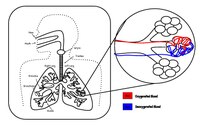
Photo from wikipedia
See Article by Sirish et al Regulation of intracellular pH (pHi) is often considered a housekeeping function, contributing little to cardiac contractile activity. With the study published by Sirish et… Click to show full abstract
See Article by Sirish et al Regulation of intracellular pH (pHi) is often considered a housekeeping function, contributing little to cardiac contractile activity. With the study published by Sirish et al1 in this issue of Circulation: Arrhythmia and Electrophysiology , a Cl−/HCO3− exchanger is revealed to have a more central role in the heart. pHiis an important modulator of cardiac excitation and contraction2 and can adversely contribute to electric arrhythmia.3 Correspondingly, cardiac myocytes express a complex apparatus to regulate pHi. Cardiac muscle cytosolic pH (≈7.2) is maintained by sarcolemmal ion transport proteins that move H+, OH−, or HCO3− ions across the membrane.4 Along with the acid extruders, Na+/H+ exchanger 1 and Na+/HCO3− cotransporter (NBC, electrogenic NBCe1/e2 and electroneutral NBCn1) myocytes possess Cl−/HCO3− exchangers (SLC4 family members AE1, AE2, and AE3) and Cl−/OH− exchanger (with no molecular identity) alkali extruders.4 SLC26 gene family members were identified as (mouse slc26a65 and its human orthologue SLC26A6,6 and slc26a37) responsible for Cl−/HCO3− and Cl−/OH− exchange at plasma membrane of heart ventricles.7 The work of Sirish et al1 in this issue revealed that ablation of slc26a6 , encoding a plasma membrane Cl−/HCO3− exchange protein, results in cardiac action potential (AP) shortening, cardiomyocyte Ca2+ transient and sarcoplasmic reticulum …
Journal Title: Circulation: Arrhythmia and Electrophysiology
Year Published: 2017
Link to full text (if available)
Share on Social Media: Sign Up to like & get
recommendations!